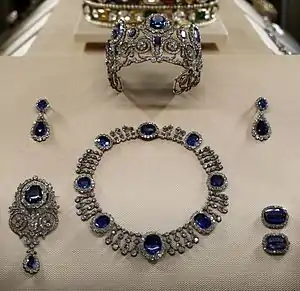Parure
A parure (/pəˈrʊər/) is a set of various items of matching jewelry, which rose to popularity early 19th-century Europe.[1]

Terminology
A parure typically consists of a combination of a matching necklace, earrings, brooch, bracelet and often a diadem or tiara. A variation is the demiparure which consists of as few as two matching pieces, such as earrings and a necklace or brooch.[2][3]
Design
Cleverly, the parure was not static but modular and could be remade into more fashionable jewelry in order to stay au courant in the court and fashion-forward for the times. Members of court and higher social ranks vied for the best jewelers to create the most imaginative and elaborate collections that would astound one another and increase their status. Some necklaces could be worn intact or temporarily disassembled into bracelets, pendants, hair ornaments or brooches with smart interchangeable components and locking systems.
Cases for storing Parure were also often highly decorative.[1]
History
The artisans under Louis XIV were credited with some of the first parure inventions in the 18th century. Diamonds, often paired with silver, were popular at that time. The standout example was created for Mademoiselle d’Aubigné’s wedding, which included: earrings, two pendants, loops and clasps for the sleeves, 32 buttons, and a large bowknot. There is a bias to towards paste parures from the period surviving to the present.[4] The low value of the component parts making them less likely to be broken up for reuse.[4]
Napoleon was fond of lavishing these gem suites on his beloved first wife, Joséphine, to wear at state functions. Later, he gave similar sets to his second wife, Marie-Louise, including a set made from cut steel.[5]
From the mid 19th century, parures made up of hair jewellery or jet pieces were made for mourning wear. [6]
References
- Tolkien, Tracy; Wilkinson, Henrietta (1997). A Collector's Guide to Costume Jewelry Key Styles and how to recognize them. Firefly Books. p. 29. ISBN 1552091562.
- Miller, Anna, ed. (1990). Illustrated Guide to Jewelry Appraising: Antique, Period, and Modern. New York: Chapman & Hall. p. 169. ISBN 978-1-4615-9717-9.
- Miller, Anna (1988). Gems and Jewelry Appraising: Techniques of Professional. New York: Chapman & Hall. p. 187. ISBN 978-0-943763-53-8.
- Phillips, Clare (1996). Jewelry from Antiquity to the Present. Thames and Hudson. pp. 116. ISBN 0500202877.
- Clifford, Anne (1971). Cut-Steel and Berlin Iron Jewellery. Adams & Dart. p. 25. ISBN 9780239000699.
- Phillips, Clare (1996). Jewelry from Antiquity to the Present. Thames and Hudson. pp. 148-151. ISBN 0500202877.
| Look up parure in Wiktionary, the free dictionary. |